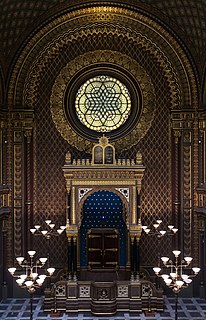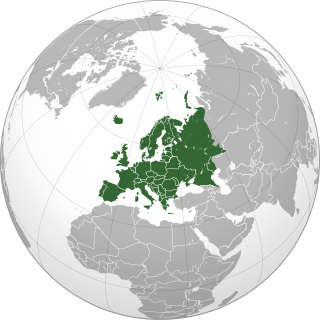Jewish artists by country:
Jewish artists by country:
| This article includes an artists-related list of lists. If an internal link incorrectly led you here, you may wish to change the link to point directly to the intended article. |
Antisemitism is hostility to, prejudice, or discrimination against Jews. A person who holds such positions is called an antisemite. Antisemitism is generally considered to be a form of racism.

The Final Solution or the Final Solution to the Jewish Question was a Nazi plan for the genocide of Jews during World War II. The "Final Solution to the Jewish question" was the official code name for the murder of all Jews within reach, which was not restricted to the European continent. This policy of deliberate and systematic genocide starting across German-occupied Europe was formulated in procedural and geopolitical terms by Nazi leadership in January 1942 at the Wannsee Conference held near Berlin, and culminated in the Holocaust, which saw the killing of 90% of Polish Jews, and two thirds of the Jewish population of Europe.

Judaism is the ethnic religion of the Jewish people, comprising the collective religious, cultural and legal tradition and civilization of the Jewish people. Judaism is considered by religious Jews to be the expression of the covenant that God established with the Children of Israel. It encompasses a wide body of texts, practices, theological positions, and forms of organization. The Torah is part of the larger text known as the Tanakh or the Hebrew Bible, and supplemental oral tradition represented by later texts such as the Midrash and the Talmud. With between 14.5 and 17.4 million adherents worldwide, Judaism is the tenth largest religion in the world.

Zionism is the nationalist movement of the Jewish people that espouses the re-establishment of and support for a Jewish state in the territory defined as the historic Land of Israel. Modern Zionism emerged in the late 19th century in Central and Eastern Europe as a national revival movement, both in reaction to newer waves of antisemitism and as a response to Haskalah, or Jewish Enlightenment. Soon after this, most leaders of the movement associated the main goal with creating the desired state in Palestine, then an area controlled by the Ottoman Empire.

Ashkenazi Jews, also known as Ashkenazic Jews or, by using the Hebrew plural suffix -im, Ashkenazim, are a Jewish diaspora population who coalesced in the Holy Roman Empire around the end of the first millennium.
Jewish history is the history of the Jews, and their religion and culture, as it developed and interacted with other peoples, religions and cultures. Although Judaism as a religion first appears in Greek records during the Hellenistic period and the earliest mention of Israel is inscribed on the Merneptah Stele dated 1213–1203 BCE, religious literature tells the story of Israelites going back at least as far as c. 1500 BCE. The Jewish diaspora began with the Assyrian captivity and continued on a much larger scale with the Babylonian captivity. Jews were also widespread throughout the Roman Empire, and this carried on to a lesser extent in the period of Byzantine rule in the central and eastern Mediterranean. In 638 CE the Byzantine Empire lost control of the Levant. The Arab Islamic Empire under Caliph Omar conquered Jerusalem and the lands of Mesopotamia, Syria, Palestine and Egypt. The Golden Age of Jewish culture in Spain coincided with the Middle Ages in Europe, a period of Muslim rule throughout much of the Iberian Peninsula. During that time, Jews were generally accepted in society and Jewish religious, cultural, and economic life blossomed.

The Jewish diaspora or exile refers to the dispersion of Israelites or Jews out of their ancestral homeland and their subsequent settlement in other parts of the globe.

The history of the Jews in Poland dates back over 1,000 years. For centuries, Poland was home to the largest and most significant Jewish community in the world. Poland was a principal center of Jewish culture, thanks to a long period of statutory religious tolerance and social autonomy which ended with the Partitions of Poland in the 18th century. During World War II there was a nearly complete genocidal destruction of the Polish Jewish community by Nazi Germany and its collaborators, during the 1939–1945 German occupation of Poland and the ensuing Holocaust. Since the fall of communism in Poland, there has been a renewed interest in Jewish culture, featuring an annual Jewish Culture Festival, new study programs at Polish secondary schools and universities, and Warsaw's Museum of the History of Polish Jews.
Persecution of Jews has been a major part of Jewish history, prompting shifting waves of refugees throughout the diaspora communities.

The history of the Jews in Germany goes back to the Early Middle Ages and High Middle Ages when Jewish settlers founded the Ashkenazi Jewish community. The community survived under Charlemagne, but suffered during the Crusades. Accusations of well poisoning during the Black Death (1346–53) led to mass slaughter of German Jews and they fled in large numbers to Poland. The Jewish communities of the cities of Mainz, Speyer and Worms became the center of Jewish life during Medieval times. "This was a golden age as area bishops protected the Jews resulting in increased trade and prosperity." The First Crusade began an era of persecution of Jews in Germany. Entire communities, like those of Trier, Worms, Mainz and Cologne, were murdered. The war upon the Hussite heretics became the signal for renewed persecution of Jews. The end of the 15th century was a period of religious hatred that ascribed to Jews all possible evils. The atrocities during the Khmelnytsky Uprising committed by Khmelnytskyi's Cossacks drove the Polish Jews back into western Germany. With Napoleon's fall in 1815, growing nationalism resulted in increasing repression. From August to October 1819, pogroms that came to be known as the Hep-Hep riots took place throughout Germany. During this time, many German states stripped Jews of their civil rights. As a result, many German Jews began to emigrate.

Bricha, also called the Bericha Movement, was the underground organized effort that helped Jewish Holocaust survivors escape post–World War II Europe to the British Mandate for Palestine in violation of the White Paper of 1939. It ended when Israel declared independence and annulled the White Paper.
The Jewish question (JQ), also referred to as the Jewish problem, was a wide-ranging debate in 19th and 20th-century European society that pertained to the appropriate status and treatment of Jews. The debate, which was similar to other "national questions", dealt with the civil, legal, national and political status of Jews as a minority within society, particularly in Europe during the 18th, 19th and 20th centuries.

Beginning with the invasion of Poland during World War II, the regime of Nazi Germany set up ghettos across occupied Europe in order to segregate and confine Jews, and sometimes Romani people, into small sections of towns and cities furthering their exploitation. In German documents, and signage at ghetto entrances, the Nazis usually referred to them as Jüdischer Wohnbezirk or Wohngebiet der Juden, both of which translate as the Jewish Quarter. There were several distinct types including open ghettos, closed ghettos, work, transit, and destruction ghettos, as defined by the Holocaust historians. In a number of cases, they were the place of Jewish underground resistance against the German occupation, known collectively as the ghetto uprisings.

The history of the Jews during World War II is almost synonymous with the Jewish persecution and murder of unprecedented scale in modern times in political Europe inclusive of European North Africa. The massive scale of the Holocaust which happened during World War II greatly affected the Jewish people and world public opinion, which only understood the dimensions of the Final Solution after the war. The genocide, known as HaShoah in Hebrew, aimed at the elimination of the Jewish people on the European continent. It was a broadly organized operation led by Nazi Germany, in which approximately six million Jews were murdered methodically and with horrifying cruelty. Although the Holocaust was organized by the highest levels of the Nazi German government, the vast majority of Jews murdered were not German, but were instead residents of countries invaded by the Nazis after 1938. Of the approximately 6 million Jews murdered by the Nazis, approximately 160,000 to 180,000 were German Jews. During the Holocaust in occupied Poland, more than one million Jews were murdered in gas chambers of the Auschwitz concentration camp alone. The murder of the Jews of Europe affected Jewish communities in Albania, Austria, Belarus, Belgium, Bosnia & Herzegovina, Channel Islands, Croatia, Czech Republic, Estonia, France, Germany, Greece, Hungary, Italy, Latvia, Libya, Lithuania, Luxembourg, Macedonia, Moldova, The Netherlands, Norway, Poland, Romania, Russia, Serbia, Slovakia, and Ukraine.
The history of the Jews in Indonesia began with the arrival of early European explorers and settlers, and the first Jews arrived in the 17th century. Most of Indonesian Jews arrived from the Netherlands, Middle East, Northern Africa and Southern Europe. Jews in Indonesia presently form a very small Jewish community of about 100–550, of mostly Sephardi Jews. Judaism is not recognized as one of the country's six official religions, and members of the local Jewish community have to register as Christian or another recognized religion on their official identity cards.

The history of the Jews in Europe stretches back over two thousand years, at least. Some Jews, a Judaean Israelite tribe from the Levant, migrated to Europe just before the rise of the Roman Empire. A notable early event in the history of the Jews in the Roman Empire was Pompey's conquest of the East beginning in 63 Before Common Era (BCE), although Alexandrian Jews had migrated to Rome before this event.

The Holocaust, also known as the Shoah, was the World War II genocide of the European Jews. Between 1941 and 1945, across German-occupied Europe, Nazi Germany and its collaborators systematically murdered some six million Jews, around two-thirds of Europe's Jewish population. The murders were carried out in pogroms and mass shootings; by a policy of extermination through work in concentration camps; and in gas chambers and gas vans in German extermination camps, chiefly Auschwitz, Bełżec, Chełmno, Majdanek, Sobibór, and Treblinka in occupied Poland.

Jewish assimilation refers to the gradual cultural assimilation and social integration of Jews in their surrounding culture as well as the ideological program promoting conformity as a potential solution to historic Jewish marginalization in the age of emancipation.

Anti-Zionism is opposition to Zionism. The term is broadly defined in the modern era as opposition to the State of Israel or, prior to 1948, its establishment. It has also been defined as opposition to the political movement of Jews to self-determination within the territory variously referred to as the Land of Israel, Palestine, Canaan, or the Holy Land.

Jews or Jewish people are an ethnoreligious group and a nation, originating from the Israelites and Hebrews of historical Israel and Judah. Jewish ethnicity, nationhood, and religion are strongly interrelated, as Judaism is the ethnic religion of the Jewish people, while its observance varies from strict observance to complete nonobservance.